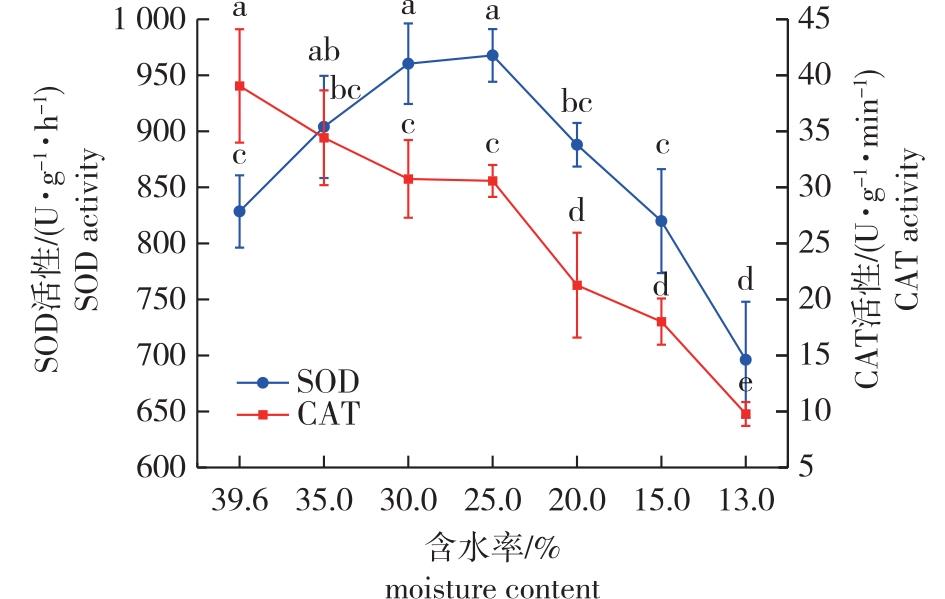 PDF(1683 KB)
PDF(1683 KB)


Physiological response of Quercus texana seeds during dehydration
ZHAO Wei, WANG Haoyu, ZHU Mingwei, XU Zhibiao, HUANG Tao, SUN Liyong, HOU Jing, LI Shuxian
JOURNAL OF NANJING FORESTRY UNIVERSITY ›› 2025, Vol. 49 ›› Issue (3) : 144-152.
 PDF(1683 KB)
PDF(1683 KB)
 PDF(1683 KB)
PDF(1683 KB)
Physiological response of Quercus texana seeds during dehydration
【Objective】Quercus texana is primarily propagated via seeds, but these are highly sensitive to dehydration, which limits their transport and storage potential. This study investigated the physiological changes occurring during seed desiccation to elucidate the mechanisms underlying their intolerance to dehydration. 【Method】Seeds of Q. texana were analyzed at moisture contents (WC) of 39.6% (fresh seeds), 35.0%, 30.0%, 25.0%, 20.0%, 15.0%, and 13.0%. Germination percentages and physiological parameters, including superoxide dismutase (SOD), catalase (CAT), proline, saccharides, soluble proteins, and malondialdehyde (MDA), were measured to explore the effects of desiccation. 【Result】When the WC exceeded 25.0%, the germination percentage remained above 90.0%. However, as the dehydration of Q. texana seeds progressed, the germination percentage progressively declined, reaching 38.3% at a WC of 15.0%. Further reduction in WC to 13.0% resulted in the complete inhibition of germination, with the percentage falling to 0.0%. The regression model (y = 0.016 5x3 - 1.553 6x2 + 47.84x - 392.03) established critical and semilethal WC at 21.4% and 16.7%, respectively. MDA levels increased continuously during desiccation, indicating heightened lipid peroxidation. SOD content exhibited an initial rise, followed by a sharp decline at 25.0% WC, while CAT activity exhibited a consistent decline, accelerating below 25.0% WC. The levels of osmoregulatory substances, such as proline and sucrose, increased up to 20.0% WC but decreased thereafter. The soluble sugars peaked at 15.0% WC, while reducing sugars steadily increased. The soluble protein content declined, though this decline was not statistically significant across desiccation stages. Correlation analysis revealed a significant positive relationship between germination percentage and SOD and CAT activities, and a negative relationship with MDA, reducing sugar, proline, soluble sugar, and sucrose levels. 【Conclusion】Q. texana seeds demonstrated a high level of intolerance to dehydration, necessitating a minimum WC of 21.4%, preferably above 16.7%, for safe transport and storage. It was observed that initial dehydration stress is mitigated by enhanced SOD activity and increased osmoregulatory substances such as proline, sucrose, and soluble sugars. However, the progressive decline in CAT activity and soluble proteins, combined with MDA accumulation and rising reducing sugars, compromises seed viability under prolonged desiccation.

Quercus texana / recalcitrant seeds / dehydration tolerance / osmoregulator / antioxidant enzyme
| [1] |
张俊杰, 蒋学皎, 郭庭鸿, 等. 顽拗性种子脱水敏感性研究进展[J]. 西北林学院学报, 2021, 36(3):144-151.
|
| [2] |
刘忠奇, 贺记外, 张海清, 等. 植物种子脱水耐性的研究现状分析与展望[J]. 中国农学通报, 2020, 36(2):36-41.
|
| [3] |
乔孝禄, 马青江, 赵婷婷, 等. 失水对沼生栎种子质量影响的研究[J]. 种子, 2018, 37(5):70-72.
|
| [4] |
|
| [5] |
张俊杰, 柴胜丰, 王满莲, 等. 珍稀濒危植物金丝李种子脱水耐性和贮藏特性[J]. 广西植物, 2019, 39(2):199-208.
|
| [6] |
杨凯, 李磊, 龙光强, 等. 顽拗性三七种子后熟过程超微结构和抗氧化酶变化[J]. 广西植物, 2016, 36(12):1519-1525.
|
| [7] |
|
| [8] |
居萍, 孙燕, 杜庆平. 白玉兰种子自然脱水过程中生理特性的变化[J]. 江苏农业科学, 2010, 38(5):250-252.
|
| [9] |
马若寒. 重庆龙眼主栽品种果实品质及种子脱水敏感性研究[D]. 重庆: 西南大学, 2021.
|
| [10] |
曹基武, 谭梓峰, 尹建, 等. 北美橡树[M]. 北京: 科学出版社, 2015.
|
| [11] |
王雄. 娜塔栎三个种源生长生理特性及园林应用研究[D]. 长沙: 中南林业科技大学, 2018.
|
| [12] |
远皓, 杨传林. 蒙古栎的价值和作用[J]. 中国林副特产, 2016(5):97-98.
|
| [13] |
许晓波. 新优树种纳塔栎秋色叶变化及其对环境的适应性[J]. 中国农学通报, 2015, 31(16):14-18.
|
| [14] |
|
| [15] |
|
| [16] |
李宏归, 丑琉懿, 廖飞勇. 赤霉素GA3对盐胁迫下娜塔栎幼苗生理特性的影响[J/OL]. 分子植物育种, 2022:1-10.(2022-04-19).https://kns.cnki.net/kcms/detail/46.1068.S.20220415.1647.028.html.
|
| [17] |
卜晓婷, 付威, 李淑娴, 等. 幼化和外源激素对娜塔栎嫩枝扦插生根的影响及其生根解剖学观察[J]. 南京林业大学学报(自然科学版), 2024, 48(2):129-136.
|
| [18] |
许樊蓉, 唐盛兰, 吴文, 等. 生物炭添加对娜塔栎容器苗生长和营养状况的影响[J]. 中南林业科技大学学报, 2022, 42(7):76-84.
|
| [19] |
国家质量技术监督局发布. 林木种子检验规程[M]. 北京: 中国标准出版社, 1999.
The State Bureau of Quality and Technical Supervision. Rules for forest tree seed testing[M]. Beijing: Standards Press of China, 1999.
|
| [20] |
李合生. 植物生理生化实验原理和技术[M]. 北京: 高等教育出版社, 2000.
|
| [21] |
高俊凤. 植物生理学实验指导[M]. 北京: 高等教育出版社, 2006.
|
| [22] |
|
| [23] |
彭麟麟. 栎属种子的低温耐受性和储藏寿命研究[D]. 昆明: 云南大学, 2022.
|
| [24] |
袁鸣, 朱铭玮, 解志军, 等. 核磁共振技术在沼生栎种子失水过程中水分相态变化[J]. 林业科学, 2023, 59(11):42-48.
|
| [25] |
马小兰, 罗永红, 闫兴富, 等. 不同大小辽东栎种子的脱水敏感性[J]. 种子, 2019, 38(1):19-24.
|
| [26] |
|
| [27] |
申婵, 钟芙蓉, 黄玲, 等. 快速脱水对后熟黄连种子萌发及生理生化的影响[J]. 中药材, 2019, 42(4):720-724.
|
| [28] |
|
| [29] |
|
| [30] |
|
| [31] |
|
| [32] |
杨舒贻, 陈晓阳, 惠文凯, 等. 逆境胁迫下植物抗氧化酶系统响应研究进展[J]. 福建农林大学学报(自然科学版), 2016, 45(5):481-489.
|
| [33] |
张宏锦, 潘萌, 郭素娟. 油脂类与淀粉类种子的耐脱水特性比较[J]. 西北农林科技大学学报(自然科学版), 2020, 48(2):80-86.
|
| [34] |
庄珍, 史锋厚, 丁彦芬, 等. 香圆种子脱水耐性研究[J]. 江苏农业科学, 2015, 43(9):229-231.
|
| [35] |
李佳琦, 薛晓明, 高捍东. 桢楠种子脱水过程中的生理响应[J]. 南京林业大学学报(自然科学版), 2021, 45(3):130-136.
|
| [36] |
冯景, 沈永宝, 史锋厚. 银杏种子脱水敏感性的研究[J]. 南京林业大学学报(自然科学版), 2019, 43(6):193-200.
|
| [37] |
|
| [38] |
|
| [39] |
|
| [40] |
|
| [41] |
陶月良, 朱诚. 顽拗性板栗种子成熟前后褐变与可溶性糖的关系[J]. 农业工程学报, 2003, 19(4):201-204.
|
| [42] |
|
| [43] |
张新静. 桔梗种子脱水耐性及其保存技术研究[D]. 北京: 中国农业科学院, 2018.
|
| [44] |
|
| [45] |
|
/
| 〈 |
|
〉 |